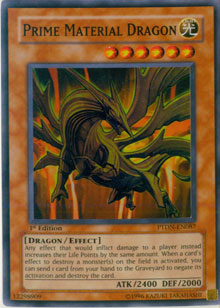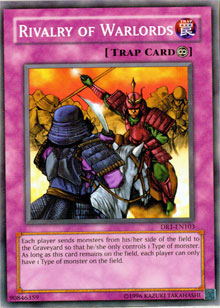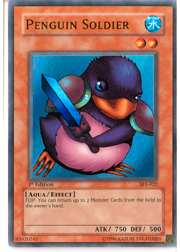The main event has barely even started, but we already saw some emerging trends and fancy tech yesterday in the Last Chance Regionals. I want to look at the top three cards that seem like they could be relevant here today, or in future events. And I want to start with one card that seems unavoidable in upcoming tournaments.
Dimensional Prison:
This sleeper of a trap card has always seemed promising, but it really came into its own yesterday. The emergence of Dimensional Prison as a competitive card here at the Canadian National Championship weekend is the result of multiple trends: some that have been around for a while, and others that are fresh from American Nationals.
First, the obvious points: several of the format’s top decks rely on monsters in their graveyard, or at least perform far better when particular monsters aren’t removed from play. Bringing Gladiator Beast Heraklinos to the field is a lot easier if you have a Gladiator Beast in the graveyard. If you have one, Gladiator Beast Darius can special summon it and turn Heraklinos’ three-monster contact Fusion requirement into what is essentially just two monsters. This has been borne out in hundreds of matches at this point and you’re likely aware of it already, but it bears discussion, because removing your opponent’s Gladiator Beast instead of destroying it will often deprive him or her of Heraklinos plays (and sometimes even Gyzarus plays). In fact, removing one of the typical Gladiator Beast’s two copies of Bestiari can be a crippling maneuver, since future copies of Elemental Hero Prisma become paralyzed if the second Bestiari winds up in the graveyard (say as a result of your first Prisma’s effect).
Dark Armed Dragon and Lightsworn also suffer when they lose monsters to the removed from play pile, since each relies on a graveyard threshold of monster presence to unleash their best attackers. It’s especially vicious against Lightsworn, because removing prime targets for Lumina, Lightsworn Summoner can render her effect sub-optimal or often entirely useless.
So that’s the obvious point: Dimensional Prison is great against three of the format’s four or five top decks because they often rely on monsters in the graveyard. But beyond that, recent factors have also contributed to this card’s popularity. Namely, Adam Corn’s showing with Prime Material Dragon at the US National Championships.
 Prime Material Dragon has this nasty little habit of never dying. With 2400 ATK it’s a match for Monarchs, Jinzo, and more. It’s virtually impossible to approach in battle, and yet it can protect itself from monster destruction. It’s shockingly hard to eliminate, especially since the monster removal card of choice for most duelists is Bottomless Trap Hole — a card that Prime Material Dragon negates with ease due to Bottomless’ “destroy and remove” text.
Prime Material Dragon has this nasty little habit of never dying. With 2400 ATK it’s a match for Monarchs, Jinzo, and more. It’s virtually impossible to approach in battle, and yet it can protect itself from monster destruction. It’s shockingly hard to eliminate, especially since the monster removal card of choice for most duelists is Bottomless Trap Hole — a card that Prime Material Dragon negates with ease due to Bottomless’ “destroy and remove” text.
But check out Dimensional Prison — it doesn’t actually “destroy” anything. It skips straight to the point and removes the monster it targets. That means it can get Prime Material Dragon off the field, and if the Dragon isn’t the monster attacking, you can still remove whatever’s harassing you. It can’t touch Dimensional Prison; it’s always a live card.
Corn-esque Monarch builds were a common sight here yesterday in the Last Chance events, as well as the 2008/2009 season Regional Qualifier. With Prime Material Dragon now the basis for a powerful strategy, as well as a splash-able side for non-Monarch strategies, Dimensional Prison is likely to see more and more play as the weeks wear on.
Rivalry of Warlords:
I only saw Rivalry in Last Chance qualifier’s Dominic Lacaille’s Six Samurai deck yesterday, but I was really amazed at how good it proved to be. Like in the case of Dimensional Prison, the expected matchups in this format are the driving factor behind this card’s viability.
 Gladiator Beasts, Lightsworn, Dark Armed Dragon, and Monarchs all run a variety of monster types — there’s no real consistent theme on that particular level. Gladiator Beasts run a Fish monster, two Winged-Beasts, two Rock-types, a Reptile, and four Beast-Warriors just in their lineup of Gladiators. We're not even talking about Fiends (Sangan) or Warriors (Elemental Hero Prisma). Add those in, and you're looking at a deck that packs seven different monster types into one strategy, with the most important beatsticks (the Beast-Warriors and Warriors) being in direct conflict.
Gladiator Beasts, Lightsworn, Dark Armed Dragon, and Monarchs all run a variety of monster types — there’s no real consistent theme on that particular level. Gladiator Beasts run a Fish monster, two Winged-Beasts, two Rock-types, a Reptile, and four Beast-Warriors just in their lineup of Gladiators. We're not even talking about Fiends (Sangan) or Warriors (Elemental Hero Prisma). Add those in, and you're looking at a deck that packs seven different monster types into one strategy, with the most important beatsticks (the Beast-Warriors and Warriors) being in direct conflict.
The Lightsworn are a mix of Spellcasters, Warriors, Fairies, Dragons, Beasts, and Beast-Warriors. There are no Monarchs that share a monster-type, while their most common support monsters vary wildly, from Dragons (Dark Armed Dragon) and Machines (Dekoichi the Battlechanted Locomotive) to an Aqua (Treeborn Frog), and Rock-types (Legendary Jujitsu Master).
This spread of monsters wouldn't create any sort of problem in a normal situation, but, with Rivalry of Warlords out, things become problematic. It’s impossible to summon Gladiator Beast Gyzarus unless you actually control two Gladiator Beast Bestiari or two copies of Prisma — not a likely situation. If you control two Gladiator Beasts, then tagging out becomes almost impossible. On the Lightsworn side, special summoning Judgment Dragon becomes virtually impossible, and swarming the field is almost as difficult.
In the right deck, Rivalry of Warlords is both mass removal and a deadly form of control. Currently “the right deck” is essentially just Six Samurai, since they’re the only frequently-played strategy with synergy on the monster-type level. But for any deck that emerges with that quality over the next couple of months, Rivalry is something to be considered.
Penguin Soldier:
This one was both hilarious, and effective. Tony Bernard played a single copy as tech in his unique Chain Energy Burn deck yesterday, and its impact was felt multiple times throughout the third Last Chance Qualifier. While Bernard fell in the end to Adrian Sado, his memorable plays presented some very interesting ideas for duelists willing to glean lessons from them.
 Again, Penguin Soldier is a nice fit for several matchups in this format, bouncing away swarms of Lightsworn monsters two at a time or prying apart the defenses of a Monarch or Dark Armed Dragon deck. Dekoichi? Bounce! Gravekeeper’s Spy? Bounce! And of course, it’s at its best against Gladiator Beasts.
Again, Penguin Soldier is a nice fit for several matchups in this format, bouncing away swarms of Lightsworn monsters two at a time or prying apart the defenses of a Monarch or Dark Armed Dragon deck. Dekoichi? Bounce! Gravekeeper’s Spy? Bounce! And of course, it’s at its best against Gladiator Beasts.
There are several play patterns the Gladiators fall into that Penguin Soldier can take advantage of. If you set Penguin Soldier and the Gladiator player sets a monster in response, you can bounce it and then swing with impunity. If that player attacks into Penguin Soldier, you bounce his or her attacker and up to one other Gladiator Beast in order to deprive the opponent of the opportunity to tag out. You can even bounce a Darius that’s grabbed a Laquari or another beatstick in order to eliminate both the Darius, and the monster it brought back from the graveyard.
The most brutal move Penguin Soldier makes possible is the one we saw yesterday. Just like Ryko, Lightsworn Hunter, Penguin Soldier absolutely wrecks Gladiator Beast Heraklinos, presenting a monster-based answer that Heraklinos can’t negate. But when Ryko destroys Heraklinos, it goes to the graveyard, where it can be brought back through Monster Reborn, Premature Burial, or even Darius (albeit without its effect in the latter case). When Penguin Soldier pokes Heraklinos with his little sword, Heraklinos goes all the way back to the Fusion deck. That means no recursive plays, and no chance of bringing back Heraklinos without another contact Fusion. Harsh.
I’m not exactly sure where I’d play Penguin Soldier, but there’s got to be some place that it could prove to be useful tech. In Monarchs, it easily takes the place of another flip effect monster, making for a bizarre and shocking side deck choice in the right matchups. I’m not sure that it’s the right time for this card to be played, but that time may arrive in the near future. Until then, we can at least all laugh at how awesome this card can be in the right scenario.
There are a lot of great new ideas here at this event, and it’s going to be cool to see which of them actually make it to the Top 8. There are definitely influences here that will carry over to Philadelphia next week, but for now, the key tech from yesterday is definitely worth consideration. We’ll bring you another tech update based off performance here in the main event later today, sometime after we explore the awesomeness that is Yannick Dubeau’s deck.